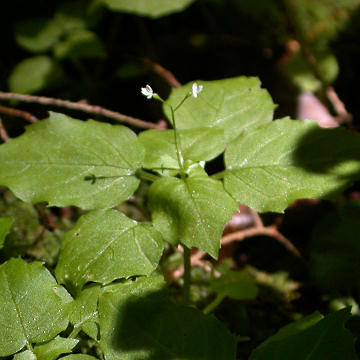

Circaea alpina - (image 1 of 4)
Taxonomy
Family: Onagraceae
Habitat
Moist to wet woods or boggy ground.
Associates
On old logs it occurs with Mitella diphylla, Saxifraga pensylvanica, and Viola incognita and on boggy ground with Betula allegheniensis, Coptis trifolia, and Rubus pubescens.
Distribution
Circumboreal; south in North America to NY, IN, IA, and SD and in mountain to NC, TN, and NM.
Morphology
Herbaceous perennial; rhizomes tuberous-thicked at the end; stems weak, to 30 cm. Leaves opposite, thin, ovate or deltoid-ovate, to 6 cm, usually more than half as wide as long, acute, undulate-dentate, cordate or less often broadly truncate at the base; pairs of leaves tend to orient perpendicular to adjacent pairs; petioles thin, rather flat above, with a conspicuous thin median wing below.
Flowers in terminal racemes, usually with fewer than 15 flowers, clustered at the top at anthesis but elongating to 10 cm in fruit; pericels to 6 cm, smooth, spreading to slightly deflexed in fruit; sepals 1-2 mm, white or pinkish, glabrous, petals 2, 1-2.5 mm, cleft to about the middle or less. Fruit 2-3 mm, unilocular; seed solitary, round, oblong, covered in bristles that adhere to fur or clothing, and thus disseminated by animals.
Notes
Flowers June to August
Wetland indicator: Facultative Wetland
Smaller and less common than C. lutetiana. The plants pictured are var. alpina.
References
Gleason, Henry A. and A. Cronquist. 1991. Manual of Vascular Plants of
Northeastern United States and Adjacent Canada. Second Ed.
The New York Botanical Garden. Bronx, NY
Swink, F. and G. Wilhelm. 1994. Plants of the Chicago Region.
Indiana Academy of Science. The Morton Arboretum. Lisle, Illinois.
|
Michael Hough © 2010 |